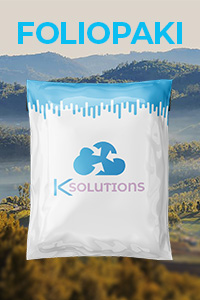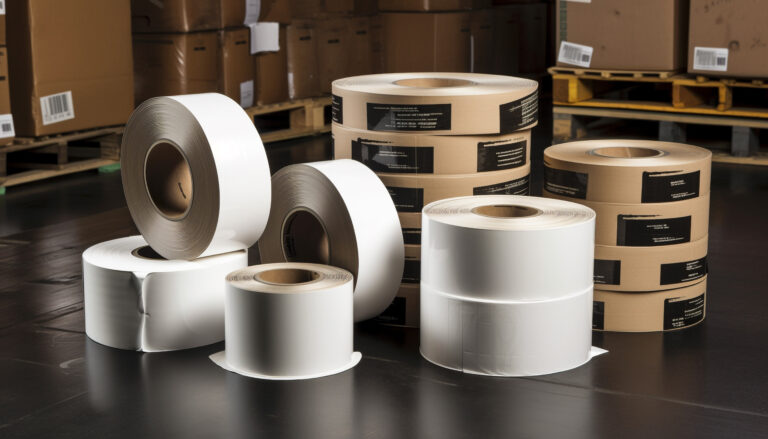Packing tape what adhesive will work best?
In day-to-day work in warehouses, logistics or home packaging, the choice of the right adhesive is crucial to the durability of the closure, the safety of transportation and the convenience of use. The type of adhesive influences whether the product will cope with harsh conditions such as moisture, extreme temperatures or rough surfaces. In this article we will discuss in detail the types of adhesives, their applications and practical tips to help you make the best decision.
1. types
1.1 Acrylic
They are characterized by transparency and resistance to aging. Thanks to the use of an acrylic adhesive, based on an aqueous emulsion, they are excellent for long-term storage due to their resistance to UV radiation. The production of these solutions emits less harmful substances, making them more environmentally friendly.
Application: light office and packaging work, such as sealing envelopes or gluing documents together. They do not perform well in cold conditions or under heavy loads.
1.2 Hot-melt
Products based on synthetic rubber adhesive are distinguished by high initial adhesion. Thanks to their flexibility, they perform well on more difficult surfaces, providing a fast and strong seal.
Application: packaging of heavy items and quick application in logistics and storage. The disadvantage is less resistance to varying temperatures and UV radiation, which limits their use in outdoor storage.
1.3 Solvent
Solutions with natural rubber adhesive are distinguished by their high resistance to moisture, extreme temperatures and harsh conditions. They perform well on irregular surfaces such as plastic, metal and wood.
Application: operation in environments with high humidity or fluctuating temperatures. They are often used in industry and transportation where durability is required.
Comparison of types of adhesives
- Acrylic are best suited for light applications and long-term storage in permanent conditions.
- Hot-melt are distinguished by their speed and excellent adhesion, ideal for heavy use in logistics.
- Solvent is a reliable choice for demanding conditions and irregular surfaces.
Each solution has its own unique features, which are worth analyzing, taking into account the requirements of a specific project. The key question is: packaging tape - Which adhesive to choose? The answer depends on the surface, conditions of use and specific needs.
2. how does the adhesive in packaging tapes work?

2.1 Adhesion mechanism
How an adhesive bonds to a surface - adhesion and cohesion
The basic action of the adhesive is based on two processes: adhesion and cohesion.
Adhesion is the ability of a substance to adhere to the surface to which it is applied. For packaging products, the compatibility of the adhesive with different materials, such as paper, plastic, metal or cardboard, is crucial.
Cohesion refers to the adhesive's internal cohesive strength, which ensures its durability after application. The better the cohesion, the lower the risk of delamination during use.
The two processes work together to make the product effective. For example, hot-melt solutions are distinguished by strong initial adhesion, while the packaging tapes with solvent adhesive has higher cohesion, making it reliable in harsher conditions.
Factors affecting the performance of the adhesive:
- Surface type: Smooth materials, such as glass or metal, require adhesives with greater adhesion, while rough cardboard works better with more flexible adhesives.
- Application temperature: Low temperatures can reduce the adhesive's ability to bond, so solvent adhesive products are better in cold conditions.
- Humidity and contamination: Dirt or moisture on the surface can weaken the strength of the bond, which should be taken into account when choosing.
2.2 Differences between adhesives
Effect of chemical composition on adhesion and durability
Each type of adhesive used in packaging materials has a different chemical composition that affects its properties:
- Acrylic: Created on the basis of aqueous emulsions. Resistant to UV radiation and aging, but less effective at low temperatures.
- Hot-melt: Made of synthetic rubber. Provides high initial adhesion, but is less durable under high temperature fluctuations.
- Solvent: Contains natural rubber. It handles moisture, extreme temperatures and difficult surfaces perfectly.
These differences mean that the answer to the question "which adhesive to choose?" depends on the specifics of the application.
How to choose the right adhesive for packaging tape?
3.1 Surface types
Cartons
Hot-melt solutions are most often chosen for standard-textured packaging, as their high adhesion allows quick and effective sealing. For rougher surfaces, solvent adhesive products that adhere better to irregular structures will be better.
Foils and slippery surfaces
For wrapped items such as food products, acrylic solutions are recommended for their versatility and resistance to peeling in wet conditions. However, for slippery films, hot-melt may prove more effective.
Rough surfaces
For materials such as wood or textiles, solvent adhesives work best, as their flexibility ensures a durable and secure bond.
3.2 Storage and transportation conditions
Effect of temperature
The choice of a suitable solution should take into account temperature conditions:
- Low temperatures: Products with solvent glue maintain adhesion even in sub-zero temperatures, making them indispensable for cold storage and winter transportation.
- High temperatures: Acrylic adhesives are more resistant to heat and UV radiation, making them ideal for outdoor applications.
Humidity and light exposure
Long-term storage in damp warehouses requires solvent adhesives that do not lose their properties when exposed to moisture. Acrylic solutions, while UV resistant, may not do well in high humidity environments.
3.3 Purpose
Short-term use
For one-off tasks, such as quickly sealing a package for shipment, hot-melt adhesive products that offer instant bonding and are economical will be suitable.
Long-term storage
In situations where packaging will be stored for long periods of time, especially in harsh environments, solvent adhesives are the best choice due to their durability and resistance to aging.
Choosing the right adhesive is a key element in ensuring the effectiveness and durability of packaging. With the right fit, you will avoid problems with peeling or lack of adhesion in harsh conditions
4. comparison of adhesives in packaging tapes

4.1 Performance of adhesives under different conditions
Examples of application and effectiveness
The performance of an adhesive in packaging solutions depends on many factors, such as the type of surface, environmental conditions and the method of application. Each type of adhesive is characterized by unique properties:
- Acrylic glue:
Ideal for conditions with stable temperatures and low humidity. For example, acrylic products are great for offices and lightweight packaging, where aesthetics and UV resistance are important.- Efficiency: High in long-term indoor storage.
- Hot-melt glue:
Highly effective in situations where speed of application and immediate bonding are key. Often used in warehouses and logistics to secure heavy packages.- Efficiency: Optimal for short-term use under standard conditions.
- Solvent glue:
The most versatile in terms of resistance to harsh conditions such as moisture, extreme temperatures and irregular surfaces. Excellent in the transportation industry and in storage in warehouses with varying temperatures.- Efficiency: Reliable for long-term storage and transportation in demanding conditions.
Key performance differences:
- Acrylic solutions are distinguished by their aesthetics and resistance to aging.
- Hot-melt is a fast and economical option, but less durable in harsh conditions.
- Solvent offers maximum strength and flexibility for industrial applications.
4.2 Cost and availability
How the price of glue affects the choice of solution
The cost of packaging products largely depends on the adhesive used:
- Acrylic: The most economical and widely available. Their lower price makes them a popular choice for office and home applications.
- Hot-melt: They are in the medium price range. They are more versatile than acrylic, making them a preferred option in warehouses and logistics.
- Solvent: The most expensive, but their higher cost is justified by their durability and versatility. Used in industries where quality is critical.
Choosing the right product should take into account the cost-benefit ratio. Cheaper options may be cost-effective in the short term, but their improper use can lead to problems such as peeling or damaged shipments, which generate additional costs.
5. the most common mistakes when choosing a packaging solution
5.1 Mismatch between product and surface
One of the most common mistakes is to choose an option without considering the specifics of the surface it will be used for. Examples:
- Smooth surfaces: Choosing an adhesive with poor adhesion, such as acrylic, can result in peeling.
- Rough surfaces: The glue's lack of elasticity, as in hot-melt, hinders effective bonding.
How to avoid it? Thorough testing before using more product.
5.2 Ignoring storage conditions
Conditions of use are crucial:
- Low temperatures: The use of acrylic adhesives in cold storage leads to a loss of adhesion.
- High humidity: Hot-melt products can lose their properties in humid environments.
Solution: Analyze storage and transportation conditions before selecting a suitable solution.
5.3 Choosing cheaper products at the expense of quality
Being driven solely by price is one of the most common mistakes. Cheaper options, while initially more economical, can lead to:
- Weaker shipment security.
- The need to use more material.
- Parcel Damage and Complaints.
Example: Hot-melt solutions are cheaper than solvent, but will not provide sufficient durability in extreme conditions.
Solution: A balance between price and quality, especially in situations requiring durability.
Mistakes are most often due to ignorance of the differences in adhesives and their applications. Understanding aspects such as performance, cost and adaptation to surfaces and conditions is key. The right solution streamlines the packaging process and minimizes the risk of problems during transportation and storage.
6 Practical tips for buying packaging materials
6.1 What to look out for?
Testing the glue
Before buying a larger quantity, it is a good idea to test the adhesive on the packaging tapes with logos In the target conditions of use. The adhesive may react differently depending on the type of surface, temperature, humidity and storage time. Special attention should be paid to:
- Initial adhesion - Whether the product binds quickly and effectively to the surface.
- Cohesia - bond durability over a longer period of time, especially in demanding conditions.
Note: The use of the wrong adhesive, such as acrylic glue in cold storage, can lead to peeling and damage to the packaging.
Material thickness
Thickness affects both strength and functionality:
- Thinner options (25-30 microns) are suitable for lightweight packaging, such as sealing envelopes or lightweight cartons.
- Thicker products (above 40 microns) are more resistant to tearing and work better with heavy packages.
Tip: When packing goods with sharp edges, thicker material with a strong adhesive such as solvent will provide reliable protection.
Tear resistance
Tear resistance is especially important during transportation and storage. When testing a product, check the strength for:
- Stretching - important in hot-melt solutions that must withstand dynamic movements during application.
- Cuts and mechanical damage - key in international transportation.
6.2 Recommended brands and products
Examples of products for different needs:
- Acrylic:
- Brand name: Scotch Transparent Tape
- Use: Lightweight and aesthetically pleasing, ideal for office and dry storage.
- Advantages: suitable for long-term storage.
- Hot-melt:
- Brand name: Tesa Hot-Melt 4024
- Application: packing heavier packages in standard warehouse conditions.
- Advantages: fast application and high adhesion.
- Solvent:
- Brand: 3M Solvent Tape 371
- Application: Extreme conditions, irregular surfaces, long-term transportation.
- Advantages: unmatched temperature and moisture resistance.
Summary
Choosing the right solution depends on a number of factors, such as the type of surface, storage conditions and the purpose of the packaging. The answer to the question posed in the title depends on the individual user's needs and the specific application. It is always a good idea to test a product before a larger order to ensure that it will do its job in the target conditions.
FAQ section
Are hot-melt adhesive solutions suitable for long storage?
Hot-melt offers high initial adhesion, but its resistance to aging and extreme conditions such as low temperatures and UV radiation is limited. Therefore, it is better suited for short-term applications, such as warehouse logistics.
What kind of glue to choose for low-temperature packaging?
For low-temperature applications, a solvent adhesive solution would be the best choice. The natural rubber exhibits high resistance to extreme conditions, allowing it to bond securely even in cold storage or during transportation in winter conditions.
Are acrylic adhesives strong enough for heavy parcels?
Acrylic products are more suitable for light to medium loads. For heavy parcels, a better choice would be hot-melt or solvent, which offer higher adhesion and durability, especially in harsher conditions.







